|
Home | Blog Index | Blog Archives | Christianity & Faith Essays | Storm Chasing Essays
Lightning photo fakes: how to spot one
|
In September of 2025, my work is generating the most income it ever has in my career. Yet, I'm being forced to shut down my successul operation, against my will, due to one cause alone: 95% of that revenue is being stolen by piracy and copyright infringement. I've lost more than $1 million to copyright infringement in the last 15 years, and it's finally brought an end to my professional storm chasing operation. Do not be misled by the lies of infringers, anti-copyright activists and organized piracy cartels. This page is a detailed, evidenced account of my battle I had to undertake to just barely stay in business, and eventually could not overcome. It's a problem faced by all of my colleagues and most other creators in the field. |
I spend time every day searching for new lightning photos and videos posted in various places on the internet. This is mainly to patrol for copyright infringement of my own work, but these searches also will occasionally turn up some interesting new shots I hadn't seen before. I also come across many deceptively fake images, a phenomenon that seems to be increasing among amateur and professional photographers alike.
I'll start out by saying I'm not against using digital manupulation or fabrication in an image, as long as it is clearly disclosed to the viewer/buyer. For example, I routinely "stack" multiple lightning shots taken in the same session when the camera has not moved in between shots. But I always clearly label those images as digital composites, even going so far as giving them their own catalog classification (all of my stacked images have a catalog number that begins with "ST"). The intent is to be honest and not deceive a viewer/potential buyer. Most people love the stacked images and many have bought prints, which is why I will continue to produce them when possible. If a viewer doesn't like stacked lightning images, I have all of the single exposures listed alongside them to satisfy any photographer's tastes.
The problem I see with many of the fakes online is that there is clear intent to decieve the viewer, and judging from the comments and re-shares of such images, there is little ability for the average viewer to discern whether or not something is a fake. So, I thought I'd put together this short guide on how to spot one.
Types of lightning fakes
There are two basic types of fake still images of lightning:
Composites: A true composite is different than a stack. This is where an image of lightning is overlaid/composited into a completely separate image taken at a different time and location. For example, a nighttime photo of lightning in a rural setting is composited into the sky in a shot of a city. The easiest ones of this type to identify are when the photographer tries to composite a nighttime lightning image into a daytime scene.
Digitally-created lightning bolts: A more commonly-seen fake is when the photographer overlays either computer-generated or drawn lightning bolts into the scene. These are a little easier to spot of you are keenly familiar with what real lightning bolts and branches look like (we'll get to that next).
Digitally-generated lightning capability can be found in plugins for Photoshop and other graphics software. This functionality has been around a long time - the following image is an example of Paint Shop Pro's "Picture Tube" lightning feature, which was available as early as 2000!
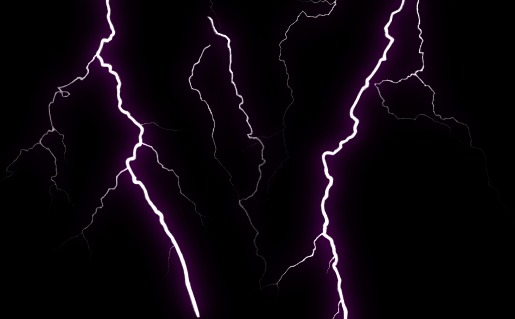
First and foremost: Become familiar with real lightning
When you've been interested in lightning and shooting photos of it for decades, spotting a fake is very easy. When you are familiar with the shape and look of real lightning, fakes stand out prominently. So, let's take a look at some real lightning! Take note of several characteristics of the real thing:
- The tortuosity of the channels (how many times the channels change direction and how sharply they change)
- The main channel of a cloud-to-ground bolt generally stays the same width and brightness from cloud to ground
- The color/hue of the channels
- The width of the main channel relative to the branches
- The number of branches coming off of the main channel
- The spacing between branches coming off of the main channel
- A significant difference between the brightness of the main channel and branches
- The existence of branching that begins above the cloud base
- The length of the branches being shorter when they start closer to the ground
- Branches generally becoming dimmer the farther they are from the main channel
Real Cloud-to-ground lightning:
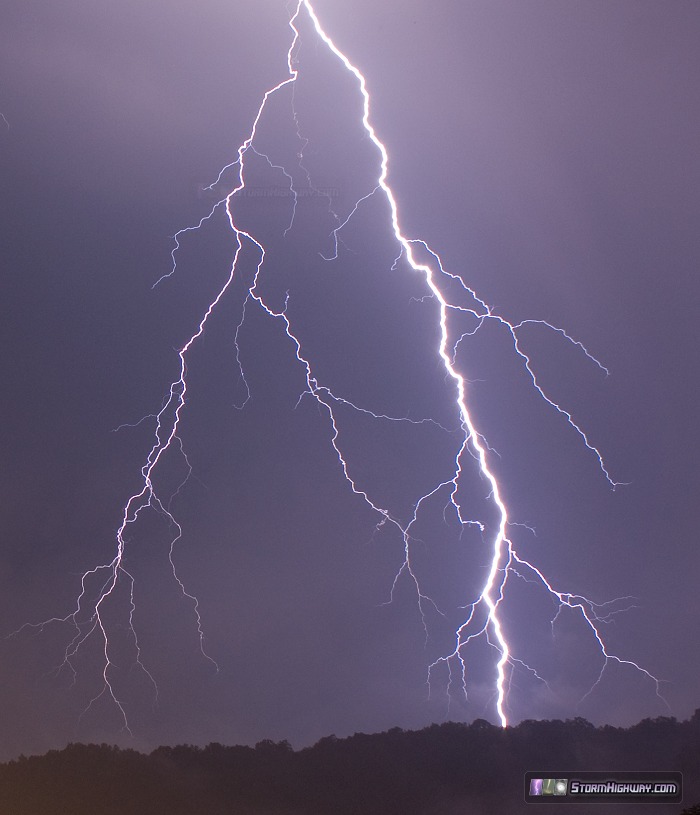

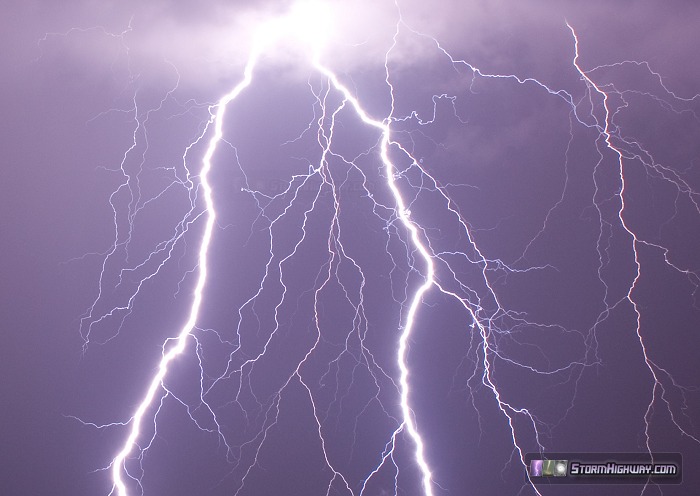
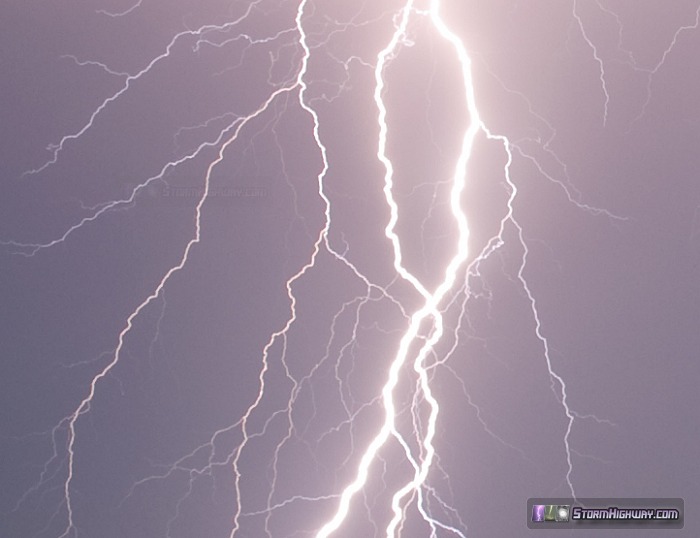
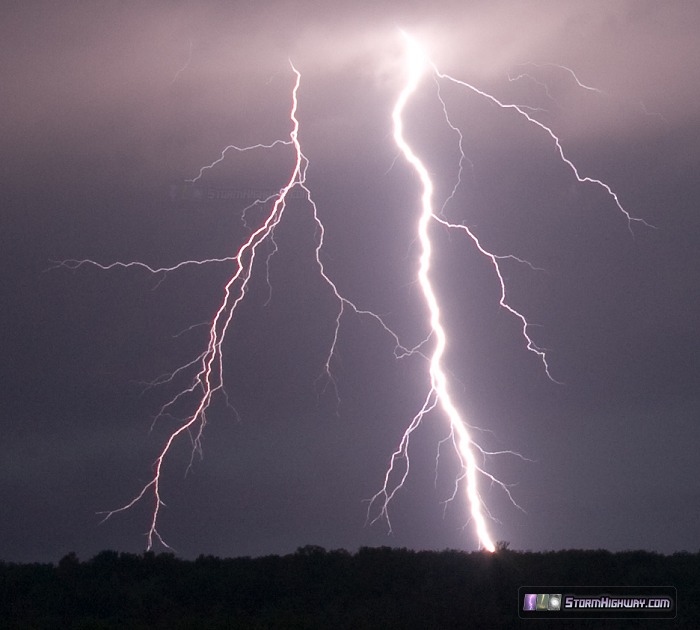
Real Intracloud/anvil crawler lightning:

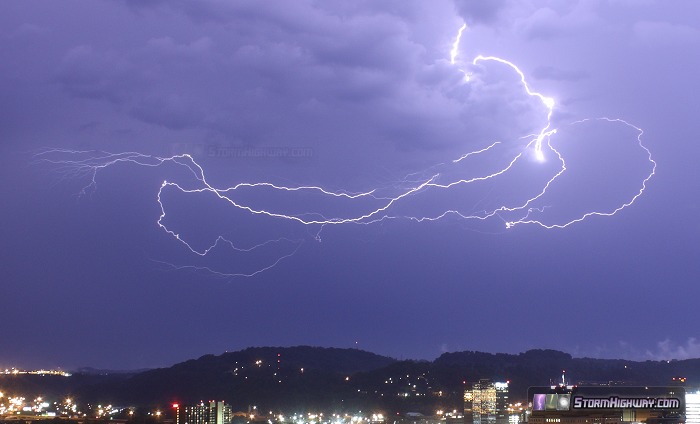
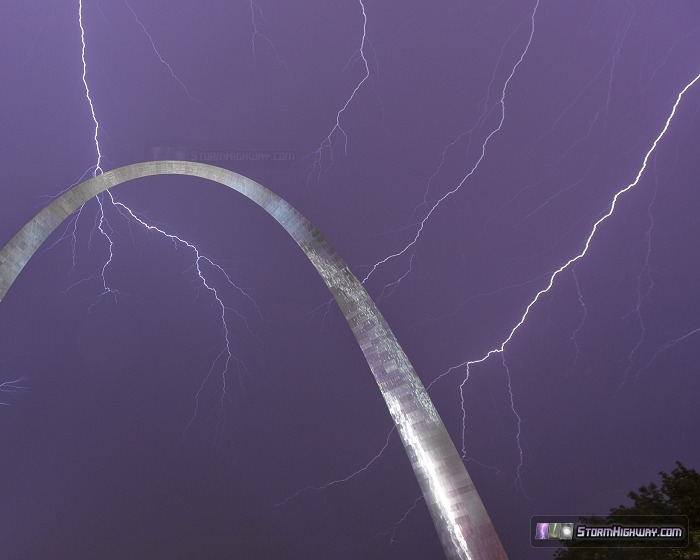
Now, I'll post links to a few fakes (I obviously can't display them here on this page due to copyright). Pay special attention to how each photographer presents and describes the images, which is my main objection. These wouldn't be a problem if they were disclosed as manipulations so as not to decieve viewers/buyers. This will be a continually-updated section as time goes on - I'm always coming across new examples (and I'm sure some of the ones here will disappear).
Digital Composites
Well-done composites can be harder to spot, but there are still giveaways that can trigger your learned 'fake image' instincts. One technique I've found useful is cropping a suspicious image down to just the lightning, then performing a Google Reverse Image Search on it - which will find the source image the lightning was taken from. Sometimes a more sneaky photographer doing the manipulation will mirror-image the lightning and/or distort its proportions to make it harder to track.
Composite 1: Golden Gate Bridge lightning: This is probably one of the more elaborate fakes I've seen. When I first saw this image, I was immediately suspicious. It appeared to be a long exposure done in the evening or at night (the bridge's lights are on), yet the waves on the water are frozen in time - something only possible in a short daylight exposure. (Upon closer inspection, it appears the base scene was shot in the daytime, then the bridge lights digitally drawn in - notice the lack of aperture blade stars on the lights). When I investigated further using Google's reverse image search, I discovered the lightning bolt was taken from this Shutterstock stock image. The lightning image was flipped (mirrored), color-shifted and then widened horizontally before being composited onto the photo of the bridge. The photographer obviously put a lot of work into this, as cutting out the lightning image to fit behind all of the components of the bridge would have been quite tedious. Again, I would have no problem with this image as-is if it was disclosed up front that it was a digital composite of completely different locations.
Composite 2: Tampa bridge: Another well-done composite. What gives this one away is the reflection in the water. First, the reflection does not line up horizontally with the main lightning image (take a ruler or pencil and place it on your screen and see for yourself). Second, this photographer made the lightning's reflection a clean, exact mirror-image inversion of the lightning. But notice the reflections of all of the lights in the photo. It's not typical for water to produce crisp exact mirror reflections - not even very still, calm water. Most water reflections will be smeared or distorted, as the lights in this image are.
The fact that the lightning's reflection isn't smeared/distorted in the same way as the lights is a dead giveaway here. But even more telling is that the reflection of the road bridge (behind the railroad bridge) is visible in the water (notice the placement of the two red marker lights in the center of the bridge's arch span). Even considering parallax, notice that the lightning's 'reflection' is never blocked by this bridge in the place where the marker light reflections are. The lightning's reflection somehow 'magically' avoids being partially blocked by the bridge reflection. Here is a link to another photo taken from nearly the same location that shows how that bridge blocks the sky's reflection. A real lightning bolt would show a 'break' in its reflected image in the spot where the bridge reflection is.
The main ways to investigate composites are via reverse image search (Tineye or Google, remember to crop to just the lightning and try inverted/mirrored versions) and browsing the photographer's other images. I've seen cases before where the photographer had the individual shots in the same gallery as the composite, while still trying to pass of the composite as real! The lesser-well-done composites often have sloppy blending and haloing at the boundary where the two separate images meet. Look also for inconsistencies in reflections, shadows and cloud illumination. Most of the fakes will simply look unnatural, particularly to the trained eye.
Drawn lightning bolts
These examples all consist of lightning bolts drawn into the photo, either by hand or with computer-generated graphics. These are generally very easy to spot, as most are using software plugins that generate the bolts. These will typically have the same 'look' when used in different photos. However, some are hand-drawn with paintbrush or line tools.
Fake 1: Drawn bolt over Albuquerque: Many giveaways with this one, but I'll list a few. Notice that the "main channel" unnaturally gets smaller as it gets gloser to the ground. The branching is unnatural, with too many thin 'filaments'. Notice that despite the heavy branching, there are no branches that begin above the cloud base and emerge - all branches begin below the cloud base. Some of the branches are the same intensity of the main channel.
Fake 2: Drawn bolt over Parriott Mesa: Again, lots of unnatural branching patterns in this one are the big giveaway. The bolt's exposure is also inconsistent with this being a daytime, front-lit scene.
Fake 3: Drawn bolt over Bryce Canyon: Once again, branching patterns are a big giveaway, but also notice the unnatural tortuosity of the channels - they are too 'smooth' and lack the 'jaggedness' of a natural lightning channel.
Fake 4: Drawn bolt over Wyoming wildfire: This is an old image that has been circulating on the internet for many years, but it's a clear fake. The branching is excessive and confined unnaturally to just above the ground to below the cloud base.
Fake 5: Drawn bolt over Canyonlands National Park: Again, unnaturally excessive branching and skewed opacity/brightness of the channels.
Fake 6: Drawn bolt over Yosemite National Park: This is a more well-done fake and a little harder to spot. The main giveaway is the unnatural branching pattern and the excessive haloing of the main channel. This image was done by the same photographer as the Golden Gate Bridge photo listed above.
I dunno, even though I chase, I personally don't have a problem with fake images. And I don't have a problem with the 'artist' not telling people that it's a composite. The only exception to that rule is if they are presenting it as real (documentarian photography) and it's actually fake. I think the final outcome is what's important. I had an image that started out as a green forest. I turned it into an autumn scene. Should I have to tell everyone that it's fake? If you can't tell, then that means that my artistic idea worked.
- Posted by Melanie | | |
I'll have you know "Dan", that "Composite 2: Tampa Bridge" is absolutely authentic! IF you had a clue, you'd realize that the reflection formed by a 30 microsecond stroke of lightning average duration of a stroke of lightning)will appear significantly different than static illumination reflected on water over a 30 second exposure (the exposure time for this image). I find your pseudo expertise droll, and your insinuation re. my photo offensive.
- Posted by Ron Ciervo from St. Petersburg, Florida | | |
| Ron, I'm glad you came here to post. Anyone who would like to question my analysis can first do a Google Image search for "lightning over water" with city lights or without, and you will never see a mixture of crisp and blurred reflections by light sources. Also, why doesn't the lightning image in the water match up correctly on the horizontal plane like a mirrored reflection should? It's shifted over at least 20-30 pixels. Again, look at every lightning/water reflection on the internet and you'll see they all line up exactly on the horizontal plane. Anyone reading this can verify this for themselves by observing other images.
The biggest problem with your story, however, is the Cass Street bridge (the road bridge that is just behind the railroad bridge). Why does the lightning's reflection not get partially blocked by that bridge in the correct spot? You can clearly see where that bridge's reflection is in the water (the two red lights in the center of the arch span), but yet the lightning's reflection somehow doesn't get blocked by that bridge there. Instead it's blocked further back, by an unknown object that Google maps doesn't show exists. That's impossible. Here is a link to another photo taken from nearly the same location that shows exactly where that bridge blocks the sky. It doesn't block the lightning bolt in your image in the right place because the lightning was composited in, and you neglected that detail - one detail of several that are clear evidence of the compositing. I'm sorry Ron, but this is plainly evident.
- Posted by Dan R. from New Baden, IL | | |
Apparent "shift" is known a parallax "Dan". "Google" it and learn something.
Matt's photo and mine are not taken from even nearly the same position on UT Campus. Bogus argument.
Here's a tip "Dan" (free)...kick some other dog. You'll find that this one bites!
- Posted by Ron Ciervo from St. Petersburg, Florida | | |
Ron, the example image was taken within yards of your location. Regardless, the elevation of the bridge over the water is the same in both. Parallax is a vertical alignment issue, not a horizontal one. Nonetheless, the fact remains that the bridge reflection is right there in your image, yet isn't blocking the lightning. Look at it - you can see the two red bridge marker lights' reflections *right there* that show exactly where the bridge reflection is. Yet the lightning reflection just magically passes through the bridge reflection and isn't blocked *at all*. Parallax doesn't fly there, because you see exactly where the bridge reflection is. If it *were* parallax, in order for the lightning to be unblocked like that, the bridge reflection would have to be off camera at the bottom of the frame. But it clearly isn't, because the red marker lights' reflections are right there in plain sight. Feel free to go as public with this as you like. I'm content to let the facts speak for themselves and let the readers draw their own conclusions.
- Posted by Dan R. from New Baden, IL | | |
|